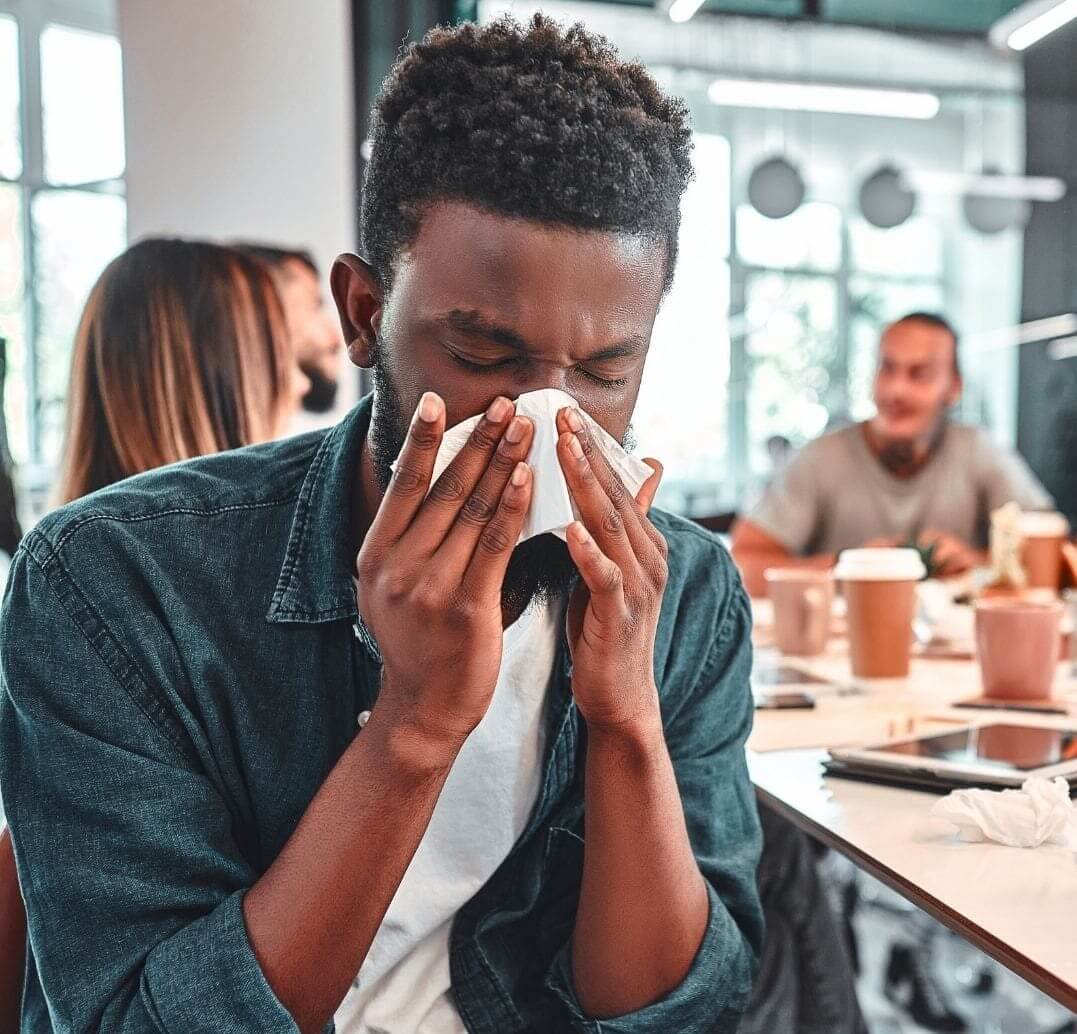With summer fast approaching, unfortunately, so is Hay Fever Season! Hay fever is a common allergic reaction that gives us watery, itchy eyes, runny noses, and tickly throats. Don’t worry, we come bearing good news – we’re here to explain what hay fever is, what causes it, and how we can treat it!
What Is Hay Fever, and What Causes It?
As we mentioned above, hay fever is a common allergic reaction to pollen. It causes some symptoms that are similar to the common cold. However, unlike a cold, it isn’t caused by a virus. Instead, hay fever (also known as seasonal allergic rhinitis) occurs when the immune system mistakes harmless pollen as a threat. To protect itself, the body produces antibodies called Immunoglobulin E (IgE) in response to this perceived threat, causing the release of inflammatory substances such as histamine. Histamine is largely what causes these irritating symptoms, hence why some of the treatments used to combat hay fever symptoms are called antihistamines!
What Are the Most Common Symptoms of Hay Fever?
Symptoms can be irritating and make you feel a little under the weather (the last thing you want when you could be out, enjoying the summer sunshine!). Before we delve into how we can reduce them, let’s take a brief look at some of the most common symptoms.
If you suffer from allergic rhinitis, it’s likely that you will have experienced some of the following:
- Sneezing
- Runny or blocked nose
- Itchy, watery, and red eyes
- Tickly or itchy throat
- Loss of smell
- Fatigue
- If you have asthma, your symptoms may flare up (you may experience more wheezing, coughing and breathlessness than usual)
Hay fever (symptoms triggered by exposure to pollen) is usually worse between late March and September, especially when it’s warm, humid and windy. Unfortunately, this is when the pollen count is at its highest.
Many hay fever symptoms are similar to those associated with the common cold. Therefore, it can sometimes be difficult to tell the difference. Here are some of the differences between the two, to help you differentiate between them.
Symptoms
| Symptom | Cold | Hay Fever | |
| Cough | Usually | Sometimes | |
| General aches and pains | Sometimes | Never | |
| Tiredness and weakness | Sometimes | Sometimes | |
| Itchy eyes | Rarely | Usually | |
| Sneezing | Usually | Usually | |
| Sore throat | Usually | Rarely | |
| Runny nose | Usually | Usually | |
| Stuffy nose | Usually | Usually | |
| Fever | Sometimes | Never |
Onset
As allergic rhinitis is an allergic reaction, you can experience symptoms immediately, or very soon after exposure to the trigger. For instance, you may start to feel your eyes becoming itchy or your nose will start to run shortly after coming into contact with pollen. In contrast, you will only start to experience cold symptoms one to three days after you have been exposed to a cold virus.
Duration
Luckily (or sometimes unluckily), hay fever symptoms will only last as long as you are exposed to allergens. When you are indoors (where there is less exposure to pollen) or the pollen count drops, symptoms should start to ease. However, pollen can stick to hair and clothing, so if you are returning indoors, having been outside, you could still be exposed. We recommend taking a shower, washing your hair, and putting on a fresh set of clothes. Conversely, cold symptoms tend to last three to seven days.
Is There Anything I Can Do to Help Reduce Symptoms?
As mentioned above, hay fever symptoms will last as long as you are exposed to pollen and so, reducing exposure to this allergen can help ease symptoms. But how do we do this?
Firstly, we would recommend figuring out what type of pollen is triggering your reaction. In general, different types of pollen will trigger a reaction at different times of the year. For instance:
- Tree pollen is likely to trigger symptoms from March until May
- Grass pollen is likely to trigger symptoms from May until July
- Weed pollen is likely to trigger symptoms from June until September
Knowing what type of pollen is causing your symptoms can help you take extra measures to reduce exposure during these times.
Here Are Some More Preventative Measures That May Help:
- Stay indoors when the pollen count is over 50 (you can follow the pollen count in your local area here).
- If you need to go outside, apply a barrier balm (like vaseline) to your nostrils to trap the pollen.
- Similarly, wearing sunglasses can help stop pollen from getting into your eyes – this is especially helpful if it’s windy.
- Try to limit time spent outside and avoid walking on or cutting the grass.
- When driving, try to keep windows closed and fit a pollen filter for the air vents in the car.
- When you return home, take a shower, wash your hair, and change your clothes – pollen can get trapped in your hair and clothes.
- If your pets spend time outdoors, try not to let them indoors as pollen can become trapped in their fur and they’ll bring it into your home.
- Similarly, avoid bringing fresh flowers inside and drying clothes outside, as this will also bring pollen into your home.
- We also recommend vacuuming often, preferably using a vacuum with a HEPA filter as they help to trap allergens.
- In addition, damp dusting surfaces will help remove pollen from around your home.
- We also suggest avoiding smoke and smoking tobacco as it can worsen symptoms.
If you’re allergic to other things (e.g. dust mites, animal fur etc.), try to avoid coming into contact with these allergens as much as possible. Some of the above suggestions, such as vacuuming with a HEPA filter vacuum and damp dusting, can help reduce your exposure to pet fur and dust mites.
What Hay Fever Treatments Can We Prescribe?
Here at Webdoctor.ie, we want you to enjoy the spring and summer months, hay fever-free. To help with this, we can provide you with a prescription for hay fever treatments via our website. We can provide prescriptions for antihistamine tablets, which can help to settle allergy symptoms by blocking the action of histamine. This can help reduce the severity of your symptoms and their duration.
In addition, we can also provide prescriptions for steroid nasal sprays. These can help to settle the inflammation in your nose which is triggered by allergens. Combination nasal sprays (steroid and antihistamine) can help to control symptoms that are not responding to steroid nasal sprays.
How Do I Take These Hay Fever Treatments?
How you would take these hay fever treatments will depend on why you’re taking them. For instance, antihistamine tablets provide more immediate but short-term relief. Therefore, you would only need to take them on days that you are experiencing symptoms. If you are taking them to ease hay fever symptoms, you may need to take them daily just for the spring and summer months.
In contrast, steroid nasal sprays take a little longer to work, but they provide more long-term relief. You can use them daily, following the instructions on your prescription to start, and lowering the dose as symptoms settle. We recommend using the minimum dose required to control your symptoms for the shortest time.
Are There Any Potential Side Effects?
Generally speaking, antihistamine medications are well-tolerated, but they are known to cause drowsiness in some patients. Therefore, we suggest monitoring how you react to these medications. If they make you feel drowsy, you should avoid driving and operating machinery as it could be dangerous. Instead, we recommend taking the medication at night.
Other potential, yet unlikely, side effects include:
- Dizziness
- Nausea
- Headache
Steroid nasal sprays are also usually well-tolerated, however, they can cause some localised minor side effects. These potential side effects include:
- Nose bleeds
- Irritation/ soreness of the nostrils or throat
- Headaches
- Unpleasant taste in your mouth
It is worth noting that some medications may impact your ability to drive and operate heavy machinery. This effect can be enhanced by consuming alcohol, and you should exercise caution until you’re aware of how this medication affects you.
As with all medications, there are potential side effects, and you should refer to the patient information pamphlet with your medication before you start to use it. If you feel you are developing side effects, we advise you to stop taking the medication and seek medical advice.
How to Request a Prescription for Hay Fever Treatments?
Requesting a prescription for hay fever treatments couldn’t be easier with Webdoctor.ie. Simply visit our Hay Fever Treatment page, and fill out the simple and secure questionnaire. This suitability questionnaire will provide our Irish-registered doctors with the information needed to ensure this treatment is safe for you. Once reviewed and approved, we will send your prescription directly to an Irish pharmacy for you via secure healthmail.
Have some questions or concerns about our Hay Fever Treatment prescription service? No problem, any of our experienced doctors would be more than happy to talk to you about the different prescriptions available and how you can use them. To speak to one of our medical team, simply book an online Video Consultation here. Our doctors are available on both evenings and weekends, so you can speak to them at a time that works for you.
Stay up to date with our prescription and online doctor services by joining our online community on Facebook, Twitter, and Instagram!






